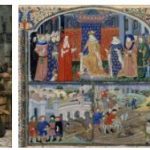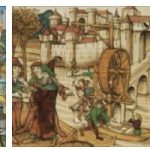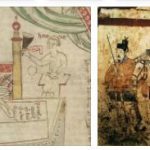The French cultural and literary preponderance, which was already felt in the 12th century, triumphed in the second half of this century with the introduction of the life of chivalry. The German vocabulary absorbed in this period innumerable elements of the new French civilization. As the terms of the life of chivalry (abenteuer, preis, harnisch, lanze, eets), as well as the dance are borrowings from French (eg., Govenanz, ridevanz) like the names of the lyric genres (schanzün, pasturele, Folate,rundate, stampenie, etc.). Even the two items that indicate the opposition of chivalrous culture to popular life, hoevisch and doerperlich, are casts from courtois and vilain. The interjections, the exclamations, the salutations of the chivalric society are French; new foreign suffixes are introduced (mat – ie in vilanîe, prophezîe ; mat – ieren, from the French infinitive ending – ier: feitieren, fr. ant. (af) faitier”to adorn”) also in the derivation from indigenous voices (eg, buobe – buoberîe ; hove – hovieren). That the use of introducing French phrases and propositions into common discourse was widespread in this social class, is attested by the German poet of Friuli, Tommasino dei Cerchiari, who in his didactic poem der welsche gast (about 1215) approves this use. Together with the French, but to a much more modest extent, it is the West Low German who gives the Middle High German his casts from the French (wâpen) Wappen “; ors ” Ross “; dörper ” Tölpel “; hersenier ” sort of helmet “from the bt”brain”): the proximity of France made the Netherlands resent the French chivalric life even before Germany. Consequence of the life of chivalry is the formation of a unitary, superdialectal literary language of a High German character; it proceeds parallel to the power of the emperors of the Swabian house (1138-1254).
While literature in the period of the emperors of the Franconian house 1023-1138) remains dialectal, the Low German poet Heinrich von Veldeke, praised by Godfrey of Strasbourg as the founder of the new poetic style (Er impete daz erste ris – In tiutescher zunge) avoids with care in his Eneit the rhymes that would have been impure in the southern dialects, which he does not do in the minor poems intended for the local environment; he renounces dialectal expressions, common in his lyrics, such as blîde”cheerful”, because they would not have been understood in Upper Germany; it is much more sparing in Frenchisms than in lyrics, because in his time (end of the 12th century) these were much more common on the Lower Rhine than at the court of the Hohenstaufen and that of Hermann of Thuringia. Further still go, after him, other North German poets who adapt themselves to High German to the point of using rhymes that are exact in High German, but impure in their own dialect. The prevalence of High German over Low German is attested by Bertoldo of Regensburg (who died in 1272), according to whom the Germans of the north, speaking with those of the south, preferred to use the dialect of the latter.kam: nam, because it would have been impure in the Bavarian pronunciation (kom: nam). The reasons for this inflexible rigorism that leads to the formation of a literary language based on High-German, far from popular use, are many: the ra ífinite knightly culture departs as far as possible from vulgar usage; it is centered in the princely courts which, in turn, tend to conform to the imperial one; multiple relations intercede between the nobility of the South and the North; fiefdoms and possessions are very often very far from the homeland of the feudatarîs; wars, parties, diets, tournaments bring knights from all over Germany to the most diverse points. Do not forget that the most important exponents of chivalric poetry lived in courts far from their place of origin. In addition to Heinrich von Veldeke, the two Southerners Wolfram v. Eschenbach and Walter v. der Vogelweide; the Swabian Hartmann von Aue writes in Franconia; the Franconian Conrad of Würzburg poet in Basel. Me too’, Nibelungi), even in the century. XII (König Rother, Rosengarten, Rabenschlacht) follows this direction: the jester, wandering from court to court, uses an interdialectal language. The linguistic difference with the chivalric epic is, more than anything else, one of degree: the first admits lexical elements such as recke or wîgant “hero”, wine “friend”, gêr “arrow”, balt “brave”, which the second rejects as too plebeian or regional, while introducing new expressions (in ” fino “, kluoc “wise”, etc.). Only the religious poetry of the century. XI (Frau Ava, Anno – lied, Ezzo – lied), because prior to this movement, and popular theater, have notable dialectal characteristics.
The prose language, considered as peasant “(gebiursch), becomes more slowly unified. The chronicles, of regional interest, are written in the local literary dialect (Sachsenchronik). More choice is the linguistic prose of Schwabenspiegel and Sachsenspiegel; it is characteristic that the author of the latter, Eicke von Repgowe (Reppichau, near Dessau), made use of the Middle German, and that only the copyists have replaced the Low German. The two great Bavarian preachers David of Augusta (1215-1271) and Bertoldo of Regensburg (died 1272) contributed to the spread of High German in prose writings. Of particular importance are the great masters of German mysticism, Eckehart of Hochheim (Gotha, died in 1327) and Heinrich Seuse who, trying to adapt linguistic expression to conceptual depth, not only enriched the lexicon with successful innovations (e.g., Eindruck, Einfluss, gleichförmig), but gave considerable impetus to the style.
According to topschoolsoflaw.com, the spread of mystical ideas throughout Germany contributed to that of a scientific, superdialectal, but frankly High German prose. With Ludwig IV of Bavaria (1314-47) the use of German in public documents began. If at first the chancery documents did not betray the tendency towards a unitary language, this changed under his successor Charles IV of Luxembourg, son of King John of Bohemia. Bohemia, where two dialects meet, up to the capital, one Middle-German, but not foreign to northern Bavarian, the other Bavarian, was predestined for the development of a central-southern chancery language. Here the innovations of vocalism leading from medieval to modern German find their application: the long î, û,iu (read ü long) are carried out to the diphthongs ei, au, eu (mîn hîts – mein Haus) – Bavarian innovation – and the Middle-High German diphthongs ie, uo, üe are assimilated to î, û, ü long (stiëge – Stiege, gruob – Grube, vrüeje – früh) – Middle-German innovation. In consonantism, albeit slowly, the Bavarian voices presenting p for b (perchrecht Bergrecht) and ch au, eu in the spelling of writers from dialectal areas extraneous to this innovation. To the linguistic unification operated by the chivalric poetry that sets in the middle of the century. XIII therefore follows a second unitary trend, which is also foreign to popular consciousness.for k (chaufhaus – Kaufhaus) they are supplanted by the Middle German forms with b, k. The constant influence of this chancery language, already modern in its phonetic structure, is betrayed in the increasingly widespread use of Bavarian diphthongs and,
A similar movement manifested itself with a regional character in the XIV-XV centuries in Northern Germany. Magdeburg, Lubeck, Dortmund, explain a leveling action, ephemeral, because with the century XVI the Low-German commercial language yields to High German. It is more interesting for its repercussions on the Scandinavian languages than for its weak influence on the development of literary German.









